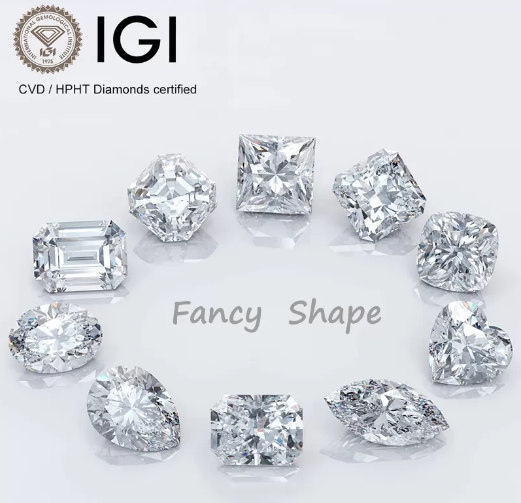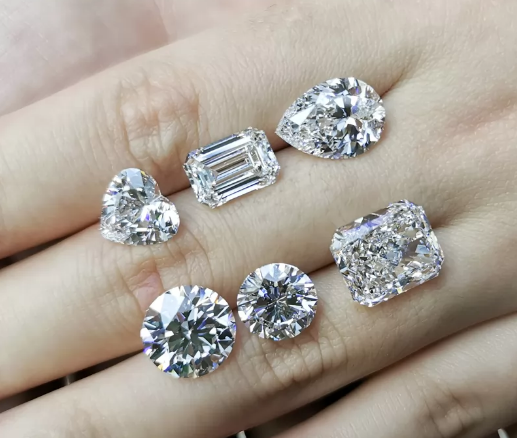What is a CVD diamond?
CVD stands for Chemical Vapour Deposition, which is the commonly used term for diamonds grown in a laboratory through the process of chemical vapour deposition. This method distinguishes itself from another frequently used process for creating lab-grown diamonds, known as HPHT (High Pressure High Temperature).
CVD diamonds are human-made diamonds, but are identical to natural diamonds and are 100% authentic diamonds. In fact, it is impossible to tell a CVD diamond apart from a natural diamond without specialist equipment.
Lab-grown diamonds are gaining popularity among engagement ring and jewelry buyers, and CVD, along with HPHT, is one of the most commonly used production methods. Choosing CVD diamond jewelry offers several advantages, including ethical origins, sustainability, and generally more affordable prices. It's important to note that CVD diamonds are typically of lower quality compared to HPHT diamonds. As the popularity of CVD diamonds rises, Queensmith's gemmologists bring specialized expertise in sourcing and selecting exquisite CVD diamonds that offer excellent value for money.

Properties of a CVD Diamond
CVD diamonds exhibit the same properties as natural diamonds, featuring identical internal structure, chemical composition, and the captivating luster. Similar to natural diamonds, CVD diamonds boast exceptional durability, ranking 10 on the Mohs scale of hardness, and showcase intense brilliance and sparkle.
Although distinguishing a lab-created CVD diamond from a natural diamond of equivalent quality is challenging, it's important to note that CVD diamonds may display less desirable traits such as brown tints and internal graining. Consequently, they often require post-growth treatment. In comparison, HPHT lab-created diamonds typically exhibit higher quality than CVD diamonds.
CVD diamonds, akin to natural diamonds, undergo grading based on cut, color, clarity, and carat weight. Despite being human-engineered, CVD diamonds share commonalities with natural diamonds and can exhibit color tints and internal flaws during their growth process. Discovering flawless CVD diamonds is exceptionally rare, with variations ranging from heavily included and poorly colored to totally colorless with minimal imperfections, mirroring the diversity found in natural diamonds. To ensure top quality and value for money, consider diamonds falling within the SI1 to VS1 clarity grades and D to F color grades.
Remarkably, even expert gemmologists face challenges distinguishing CVD diamonds from natural diamonds, as both share identical chemical, physical, and optical properties, including flaws. When purchasing a CVD diamond, the GIA or IGI certification will indicate its origin. Beyond this, specialized laboratory equipment is required to discern whether a diamond is human-made.

CVD vs. HPHT Diamonds
The distinction between CVD and HPHT diamonds lies in the methods employed for their creation. HPHT diamonds are formed through High Pressure High Temperature, simulating the natural diamond-making process that occurs deep within the Earth over millions of years. In contrast, CVD diamonds are produced using Chemical Vapour Deposition. Despite the varied processes, both types of diamonds require only a few weeks to develop, with HPHT demanding higher energy levels.
Experts generally observe that HPHT diamonds are crafted to a higher quality compared to CVD diamonds, often requiring less post-growth treatment. One notable difference is in their formation: CVD diamonds grow into a cubic shape, while HPHT diamonds take on a cuboctahedral form. This dissimilarity is subtle and typically discernible only by carefully trained experts.
It's worth noting that some laboratories may utilize a combination of both processes. Initiating the process with the less energy-intensive CVD method and concluding with HPHT can result in diamonds with impressive clarity and color. However, both CVD and HPHT diamonds remain chemically, physically, and optically identical to natural diamonds.
How to Identify a CVD Diamond?
Distinguishing a CVD diamond from a natural diamond is practically impossible without specialized laboratory equipment and gemological expertise because they are indistinguishable. CVD diamonds come in various qualities and grades, and when comparing two diamonds with the same grades, there will be no visible difference. This is reassuring for CVD diamond buyers who might be concerned about the authenticity or appearance of CVD diamonds compared to natural diamonds.
Technically, when examining a CVD diamond under magnification, one might observe different strain patterns compared to natural diamonds. However, identifying these differences requires specialized gemological knowledge, and even experienced gemologists might find it challenging.
Diamond laboratories use equipment to detect trace elements like silicon, which could be present in CVD-created diamonds. The expertise and equipment needed for this analysis are highly specialized, and submitting the diamond to a laboratory like GIA is advisable.
When purchasing a CVD diamond, ensure it comes with GIA or IGI certification. The accompanying certificate will specify whether the diamond is natural or lab-created through CVD or HPHT, and importantly, whether the diamond has undergone post-growth treatment to enhance its appearance. Diamonds with post-growth treatments should be approached with caution.
CVD Diamond Grading and Certification
Similar to naturally mined diamonds, CVD diamonds undergo grading for cut, color, clarity, carat weight, and other factors like fluorescence, polish, and symmetry. Several grading laboratories worldwide certify lab diamonds, with GIA (Gemological Institute of America) and IGI (International Gemological Institute) being among the most renowned and trusted.
GIA and IGI meticulously evaluate CVD diamonds, providing an accurate assessment of their quality, which subsequently influences the stone's pricing. These labs laser imprint a unique code onto the girdle of the diamond, visible only under magnification. This code corresponds to the paper or digital certificate, where comprehensive details about the stone, including grades, carat weight, and measurements, are outlined. The certificate also specifies whether the diamond was created through CVD, HPHT, or if it is a natural diamond.
CVD Diamond Price vs Natural Diamond
CVD and HPHT lab diamonds typically cost between 50% to 80% less than natural diamonds. Despite being more affordable than natural diamonds, lab diamonds are still considered high-value items, representing a precious and valuable commodity with costs reaching thousands of pounds. The creation, cutting, polishing, and grading of CVD diamonds involve extensive work and professional expertise.
The future value of lab diamonds remains uncertain since they are relatively new to the market, and it is unclear whether they will retain their value. Experts suggest that lab diamonds will not be inexpensive and will continue to be a significant investment. The processes of HPHT and CVD require substantial investments in advanced technology, expertise, and time. Some even anticipate that the cost of lab diamonds may increase in the future as demand rises.
Is a CVD Diamond Right for Me?
Our advice is to opt for a lab-created HPHT diamond over a CVD diamond as they consistently exhibit top-quality characteristics and lack the milky appearance often found in post-growth treated CVD diamonds.
Choosing between natural and lab diamonds is a personal decision. In simple terms, it comes down to deciding between a more affordable, ethically sourced, and environmentally sustainable option (CVD or HPHT diamonds) versus a natural wonder created over billions of years (natural diamonds).



 Lab Grown Emerald
Lab Grown Emerald



